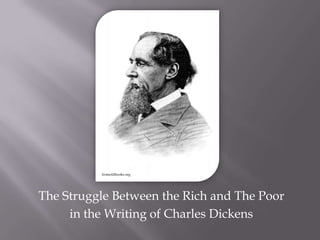9 B's presentation
- 1. fromoldbooks.org The Struggle Between the Rich and The Poor in the Writing of Charles Dickens
- 2. âThere is nothing on which [the world] is so hard as poverty; and there is nothing it professes to condemn with such severity as the pursuit of wealth.â -Scrooge to The Ghost of Christmas Past A Christmas Carol
- 3. Many of Charles Dickens novels have a theme with a definite contrast between rich and poor. Those include: âĒA Tale of Two Cities âĒHard Times âĒA Christmas Carol âĒGreat Expectations âĒDavid Copperfield and moreâĶ
- 4. Most of Dickensâ poor characters are portrayed as humble and angelic, while the Rich are usually selfish and cold-hearted. One example of a humble and benevolent poor person was Joe Gargery in âGreat Expectationsâ, who was always a loyal and true friend to Pip, even after Pip was embarrassed to be seen with him. âBut this may be said of him [Joe Gargery] that he stands for a certain long-suffering in the English poor, a certain weary patience and politeness which almost breaks the heart.â (Chesterton)
- 5. Another poor character that was angelic was Rachael from âHard Timesâ. The man she loved, Stephen Blackpool, was married to her sister. Her sister was a drunken bum, so Rachael cared for her sister and Stephen, even though she could not be married to him. ââThou changest me from bad to good. Thou makâst me humbly wishfoâ to be more like thee, and fearfoâ to lose thee when this life is ower, anâ aâ the muddle cleared awaâ. Thouârt an Angel; it may be, thou hast saved my soul alive!ââ -Stephen Blackpool to Rachel Hard Times
- 6. Other Angels include: âĒ Ham in David Copperfield â gives his own life saving the man who took his betrothed and then abandoned her. âĒ The Cratchit Family â sweet and humble family from âThe Christmas Carolâ. â Dickens sympathizes with the poor and implies that their woes result from societyâs unfairness, not their own failings.â (SparkNotes)
- 7. Many of the rich characters in Dickensâ books start out as heartless, but change over time through various circumstances they are forced to deal with. Perhaps the most famous example of this is Ebeneezer Scrooge from âA Christmas Carolâ âThe ethics of Ebeneezer Scrooge are finally redeemed by a heavy dose of Christian love and charity.â (SUU Faculty)
- 8. Dickens reversed these stereotypes in âA Tale of Two Citiesâ with the characters of Charles Darnay and Madame Defarge, Dickens reveals his non-stereotypical portrayal of nobility and peasants. He brings to light that not all aristocrats are cruel. Some aristocrats like Darnay do not want oppression nor possess a lust for money and power. Some peasants, on the other hand, can be more cruel than the aristocrats as what was exhibited by the character of the blood-lust Madame Defarge. (Raval)
- 9. Chesterton, Gilbert Keith. Chapter 20: Great Expectations. 27 September 2010 <http://www.online- literature.com/chesterton/dickensworks/20/>. Dickens, Charles. A Christmas Carol. New York, NY: Sterling Publishing Company, 2009. â. Great Expectations. London, England: Penguin Group, 1996. Dickens, Charles. "Hard Times." Dickens, Charles. Charles Dickens. New York, NY: Chatham River Press, 1988. 848. goneaway. Hard Times. 30 September 2010 <http://everything2.com/title/Hard+Times>. PinkMonkey.com. Chapter Seven: The Marquis in Paris . 28 September 2010 <http://www.pinkmonkey.com/booknotes/monkeynotes/pmTale2Cities23.asp>. Raval, Stephanie R. Tracing the Interwoven Threads of History in Charles Dickensâ A Tale of Two Cities . 16 March 2009. 24 September 2010 <http://www.scribd.com/doc/17675263/A-Tale-of-Two- Cities-Historical-Approach>. SparkNotes. David Copperfield. 27 September 2010 <http://www.sparknotes.com/lit/copperfield/themes.html>. SUU Faculty. Charles Dickens and the Social Novel. 29 September 2010 <http://www.suu.edu/faculty/ping/pdf/DickensandtheSocialNovel.pdf>.


![âThere is nothing on which [the world] is so hard as
poverty; and there is nothing it professes to condemn
with such severity as the pursuit of wealth.â
-Scrooge to The Ghost of Christmas Past
A Christmas Carol](https://image.slidesharecdn.com/9-120315032146-phpapp01/85/9-B-s-presentation-2-320.jpg)

![Most of Dickensâ poor characters are portrayed as humble and
angelic, while the Rich are usually selfish and cold-hearted.
One example of a humble and benevolent poor person was Joe Gargery
in âGreat Expectationsâ, who was always a loyal and true friend to
Pip, even after Pip was embarrassed to be seen with him.
âBut this may be said of him [Joe Gargery] that he
stands for a certain long-suffering in the English
poor, a certain weary patience and politeness
which almost breaks the heart.â (Chesterton)](https://image.slidesharecdn.com/9-120315032146-phpapp01/85/9-B-s-presentation-4-320.jpg)




